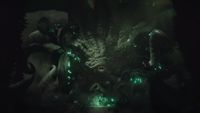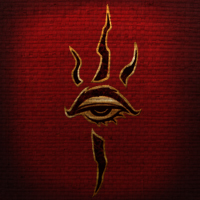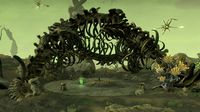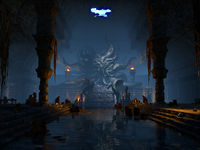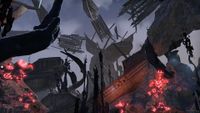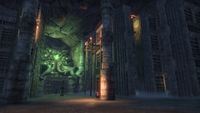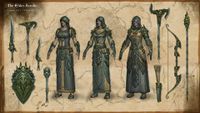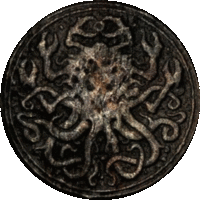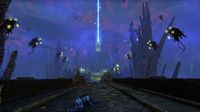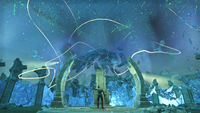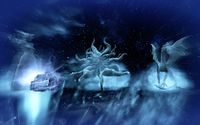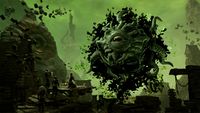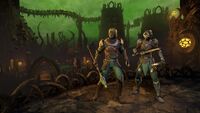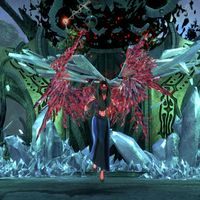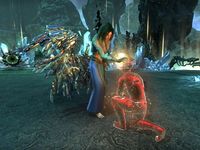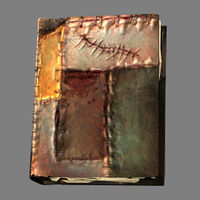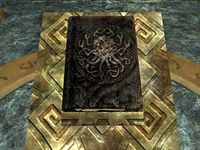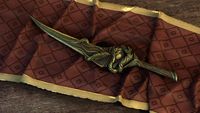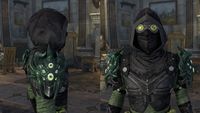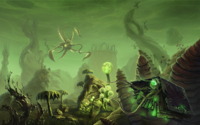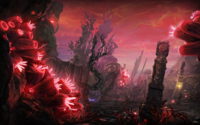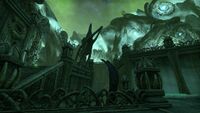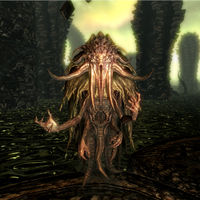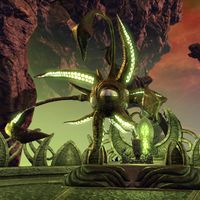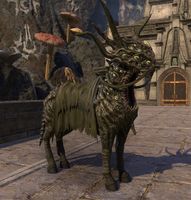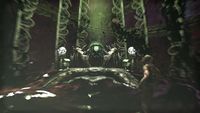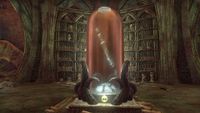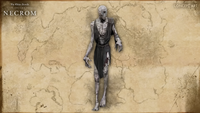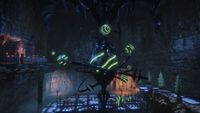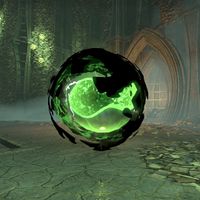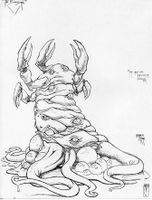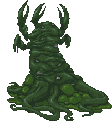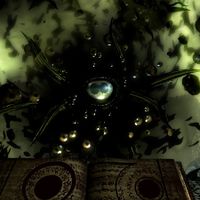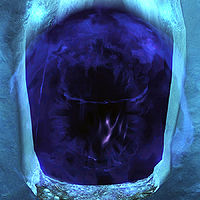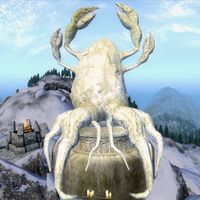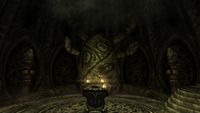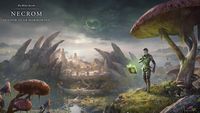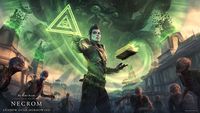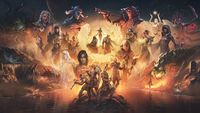Lore:Hermaeus Mora
—Hermaeus Mora[1]
Hermaeus Mora (sometimes spelled "Hoermius", "Hormaius", "Herm'us", or "Herma Mora"),[2][3][4] the Daedra Prince of Forbidden Knowledge,[5] the Demon of Knowledge,[2] the One Who Knows,[6][1] the Master of the Tides of Fate,[7] Gardener of Men,[8][UOL 1] Prince of Fate, Lord of Secrets,[9] the Keeper of Forbidden Knowledge,[10]:293 the Golden Eye,[11][12] the Great Eye,[13] Ur-Daedra,[14][15][16] the Abyssal Cephaliarch,[17] Old Antecedent, Scryer, He Who Records All Knowledge, Inevitable Knower,[14] Lord of Fate and Knowledge,[18] also known to the ancient Atmorans and Bosmer as Herma-Mora, the Woodland Man[2][19] or "that which speaks in the wastes,"[20] to the Ayleids as Hyrma Mora,[21] and to the Khajiit as the Tide King and Hermorah,[22][4] is a Daedric Prince whose sphere is forbidden knowledge,[23] hidden shoals, whirlpools, and sudden squalls,[24] destiny,[25] and the scrying of the tides of Fate, weaving his way through the past and future as read in the stars and heavens, and in whose dominion are "the treasures of knowledge and memory".[26]:585[27] His curiosity is insatiable and he seeks all knowledge, and not to change but to observe, so that all becomes known.[9][6] He "weeps cold tears" at the plague of ignorance, where knowledge is forsaken out of fear of misuse, and seeks to enlighten all to all mysteries that have ever and will ever exist.[11] One follower of Mora stated that the ultimate purpose of the Daedra lords is to instruct and improve the "generally deplorable" character of mortals.[28] This benevolence presented by his followers may be a facade, as Mora is said to hoard his knowledge and give nothing away for free.[10][25] Like all Daedric Princes, he's not to be trifled with, but he is subtler than most of his ilk and ensnares mortals with his secrets.[25] He may seem cruel at times, but he's not irrational.[9] Mora hoards and safeguards any knowledge that could potentially endanger reality.[29] According to some sources, the Mythos, the core of Mora's realm of Apocrypha which is located deep beneath the plane's Ichor Sea, is where the Prince "whispered the first secret" and "imagined the concept of knowledge", thus also conceiving Apocrypha itself in that same act.[30]
Always lurking, he is the void and the ever-seeing eyes.[26]:585 Mora has been called the wisest of the Daedric Princes, with a mind as old as Tamriel and a body of slime,[23] though he describes himself as "the riddle unsolveable. The door unopenable. The book unreadable. The question unanswerable."[31] Unlike most Princes, Hermaeus Mora typically does not take on a humanoid form, manifesting instead as black clouds of varied, grotesque assemblages of eyes, tentacles, and claws, or a featureless purple vortex known as the Wretched Abyss,[32][33] though according to some sources he occasionally took on a form resembling that of a mortal.[34] He speaks with a thundering bray,[UOL 2] and has been described as being composed of countless eyes or "orbs without end".[35][36] The energies and essences of both Hermaeus Mora and Namira are said to take the form of "roiling darkness", and are so similar to one another that additional decorative elements are required to determine which of the two an artifact belongs to. This strong similarity has caused some scholars to theorize that the two Daedric Princes share a close relationship and are linked to one another in some manner.[37]
According to Mora himself, he is "multitudes", and only adopts a singular guise for the sake of the mortals he communicates with, whose minds would crumble when confronted with such a concept.[34] The form in which he appears before mortals is described as a "delimited projection", and he is said to not communicate with them often.[38] The Watchlings of the Prince are known to sometimes serve as his proxies, as he can see through their eyes and even take control of their forms to speak through them.[39] Mora can be invoked in certain locations in Nirn using a "condensate of planar possibilities" that take a form similar to ink to summon him.[38]
He resides everywhere and nowhere but takes glee in tormenting mortals from his realm in Oblivion, the plane called Apocrypha, an endless library where the infinite pages of countless books containing all forbidden knowledge are found.[26]:585 Each book sports a black cover without a title, and the realm is reported to be haunted by ghosts forever searching for knowledge.[11][40] His servants include Daedra such as Seekers, Lurkers, and Watchers, but he is known to have mortal worshipers too.[41] Sailors and seafaring folk refer to Herm'us Mora as the Tide King, master of the seas and One-Whose-Tentacles-Rise-From-the-Deep,[42] a being who lurks in the oceans and pulls vessels down into the abyss.[43] Similarly, the Khajiiti Hermorah controls the tides and lives in a vast library under the sea.[22]
Hermaeus Mora is tangentially related to the origins of the Morag Tong by association with his sibling, Mephala.[2] Mora's enemies are said to be Ebonarm and Vaermina,[44][45] and his summoning day is the 5th of First Seed.[46] Azura considers Mora among the most powerful Princes who "stand above their lesser kith", as he was one of the eight to sign the Coldharbour Compact.[47] According to Mora's Seekers, due to the Compact, the Prince made a pact with every mortal on Nirn to cease all direct interposition in Mundial affairs, and for his agreement it seemed he was paid a great price, something he dearly desired. The compact appeared to bind in both directions, resulting in mortals no longer coming to Apocrypha as they did before.[48]
Mythic Origins[edit]
— Leramil the Wise[49]
Hermaeus Mora claims that he is one of the oldest Princes, born of thrown-away ideas used during the creation of mortality in the Mundus, even calling himself the "first secret whispered at the dawn of creation",[1][UOL 1] and has been described as "elder than Ada".[17] Imperial Mananauts have verified that his influence on fate and time is real and unfeigned, implying that Mora is tied directly with Akatosh, the prime temporal spirit whose appearance led to the formation of the world, and therefore Mora may be telling the truth.[UOL 1] As some Black Books appear to have been written in the past, and others might be from the future, time appears to be more malleable for the Daedric Prince of fate and destiny.[25]
Hermaeus Mora's primordial nature connects to his ancient connection to the sea.[50] The gigantic fossilized remains of ancient sea creatures, not known on Nirn, dot his realm of Apocrypha. Faithful of Mora believe that these fossils are remnants of another place or realm, the origin point of the Daedric Prince of Knowledge.[51] Antediluvian hunting horns carved from these fossils have been found, engraved with depictions of Mora driving beasts before him.[52] Apocrypha was said to have been created by Mora in a location now known as the Mythos, beneath the Ichor Sea. It is there where he whispered the first secret, and first imagined the concept of knowledge.[49]
Mythology and Worship[edit]
— Bruscius Longus and Norasa Adus
Hermaeus Mora has always tried to seduce mortals into his service with the lure of forbidden knowledge, and many scholars and loremasters find themselves ensnared forever by the lure of secrets only he possesses. Documented indications of Mora's permanent influence include incipient madness, loss of self-awareness, and black spots in the whites of the eyes.[25] Mora's knowledge reaches beyond mortal understanding but is evidently not infinite, as he still needs worshippers to dig up secrets for him.[9][53]
Worshippers of Hermaeus Mora that seek lost tomes to bring to Apocrypha will sometimes paint their bodies with markings resembling tentacles in his honor. Bearers of such markings cause mixed feelings in librarians, who view them with admiration for their erudition in seeking their tomes, but also fear the covetousness that can drive agents of the Golden Eye. [54][55] Mora has been known to sometimes gift his faithful with an Apocrypha Corrupted Eye, transforming one of their eyes to give it the ability see the hidden secrets of reality and to uncover the truth on the page.[56] One worshipper of Hermaeus Mora asked the Prince for "ears that could listen to dreams", and was granted his wish. The boon soon turned into a curse, however, as he became doomed to "wander a forest of waking horrors", causing him to disappear and leave behind his pet bunny, which bore the signs of Apocrypha.[57]
Ayleids[edit]
The Ayleid city of Bisnensel began to worship Hyrma Mora under the lead of High Priest Uluscant, who established a congregation in Bisnensel that attracted many of the learned and most influential people in the community. As their numbers became more numerous, on their behalf Uluscant requested more of a say in municipal affairs, a request that was denied by King Dynar. Within a few months of his rebuff, Dynar was deposed.[21] The Ayleids of Bisnensel turned the city into a shrine and stored forbidden knowledge of the natural order, which could allow one to manipulate the very fabric of reality.[58] Seeking to secure his domain from the Alessian Empire, Uluscant later made a pact with Hermaeus Mora to conceal Binsensel under a "veil of illusion and secrecy", so that no army that reached the shores of Halcyon Lake would be able to pierce the veil or even remember their purpose in marching to that location.[59]
In Shadowfen, an Ayleid sorcerer that revered Hermaeus Mora is said to have created a magical library which drew books to the location from different time periods, including the future.[60]
Bosmeri Cults[edit]
To the Bosmer, Herma-Mora is a malicious trickster spirit (one of many). Nevertheless, the Woodland Man commands a large number of devotees. However, Mora cultists in Valenwood insist that their Herma-Mora is different from the Daedric Prince Hermaeus Mora.[19] One such group was a Second Era cult, the Wooded Eye, who venerated Mora and served as guardians of the Cradle of Ilmyris—a library of secret knowledge.[61]
Dunmeri Cults[edit]
The Daedra are tied closely to the history of the Dunmer people, for good or ill. In Morrowind, Mora is known as the Golden Eye (or simply The Eye),[62] He Who Records All Knowledge, the Abider in the Abyss, Keeper of the Oghma Infinium, Master of Apocrypha, He Who Holds the Paper to the Light,[63] and the Master of the Oghma.[UOL 3] To him, knowledge and memory are the only treasures of value, gathering all words and all thoughts in the realm of Apocrypha. He has cults guarding secret libraries, such as the Devotees of Knowledge, who seek enlightenment, illumination, and a place at Mora's side.[11][12] They believe that while the Golden Eye is shunned by the crude ignorant Princes and followers of Divines alike for his wickedness, he cares little and instead watches them to document their every move. Knowledge is only as wicked as the one who wields it, and forsaking learning in fear of its misuse is an unforgivable folly that leads to mortals suffering countless centuries of loss. It is believed that pages are how Mora sees the world, so sends them out on the winds and they fill with stories. They collect information about the events around them, and when they're brought back to the book, Hermaeus learns.[11][62] When the Dagonites burned down their library and they could not salvage their books, the devotees followed the principle of knowledge gained for knowledge lost: they drained new memories from Dagon's Dremora to replace what they lost, granting their lord new knowledge on how to counter Dagon in the future.[12][UOL 3]
The Devotees believe that by dedicating ones energy, mind, and soul to Mora, he may grant them admittance into his hall of all knowledge.[62] In Apocrypha, they are permitted to browse the infinite tomes and scrolls, privy to all mysteries that have ever and will ever exist, and achieve the most blessed fate of finally sating their thirst for knowledge.[11][12]
Mora translates to "Forest" in Dark Elvish, hence he is vaguely related to the cult origins of the Morag Tong ('Foresters Guild'), if only by association with reclamation Mephala,[19] and is used in the names of many Dunmer cities such as Balmora, Sadrith Mora, and Tel Mora.[64]
Imperial[edit]
Imperial law by Uriel VII decreed that only on the official holiday of 5th First Seed should any propitiation to Hermaeus Mora be delivered, with it being stated that "All else is mutation.".[UOL 1]
Hermaeus Mora is one of the 16 acceptable blasphemes, with it being said that "HERMAEUS MORA holds the Paper to the Light."[63]
Nordic Tales[edit]
In ancient Atmora, Herma-Mora was also known as the Woodland Man (though unlike the Bosmer, the Nords acknowledge his Daedric heritage). Later research has indicated this may better translate to "that which speaks in the wastes."[20]
Most myths involving Ysgramor are about his escaping the devious schemes of Herma-Mora. He is acknowledged as a testing god.[65] Mora shares many similarities with Jhunal, which may be linked to why the latter fell out of favor in the pantheon.[UOL 4]
One fable in particular is known: Ysgramor was hunting in the Atmoran Frostwood when he sighted the White Stag of Forelgrim. After losing its trail many times, a Hare appeared, and told Ysgramor where the White Stag had gone. When Ysgramor inquired as to how the Hare knew this, it replied that it could hear it with its long ears, adding that if Ysgramor had long ears he could hear his prey wherever it went.[17]
Ysgramor idly wished his ears were as long as the Hare's; the Hare twitched its nose and Ysgramor's ears became long and pointed. Suddenly, a Fox leapt out and killed the Hare. The Fox then identified itself as Shor and the Hare as Herma-Mora, and chided Ysgramor for nearly allowing himself to be turned into an Elf. Shor then sent Ysgramor on his way, warning him to "eschew the tricks of the Elves, lest ye become one."[17]
Nords keep small statues of testing gods in their households and try to keep them appeased.[66]
Khajiit[edit]
—Fadomai, from Words of Clan Mother Ahnissi
Hermorah is known to the Khajiit as the Watcher, Spirit of the Tides,[22] and the Tide-King,[67] is the Keeper of the Knowledge of Others.[22] He was born of the second litter of Fadomai.[68] Traditionally, Hermorah records all he sees in his vast submarine library. Azurah is a frequent visitor to his domain, and Hermorah shares all he knows with her. He also helps Azurah maintain the Moons and their Motions.[22]
However, the advent of Riddle'Thar worship brought a change in thinking. Thus, more recent writings caution against Hermorah worship, describing communion with the spirit as "a fate worse than death", that will "tear a mind asunder" and "shred our sense of reality".[67] A cult dedicated to Hermorah known as the Golden Eye was active in Elsweyr during the Interregnum, where they communed at the Shrine of the Golden Eye hidden with Claw's Strike.[69]
One Khajiit myth recounts how the thief god Rajhin became curious about the treasures Hermaeus Mora kept within his library beneath the sea. Sailing to a lonely spire of rock that was the topmost spire of Mora's abode within the far reaches of the southern seas, Rajhin entered the Tide King's halls. Rajhin saw many strange things within Mora's halls, but was finally drawn to a single book resting on a podium, the Oghma Infinium. As Rajhin stretched his hand to grab the tome, Mora discovered him. Though Mora knew Rajhin was present, he could not see him, as he was shrouded by the Ring of Khajiiti. The cunning Rajhin claimed to be but a mote in Mora's eye, and asked Mora to bring out more of his eyes so he could see that said claim was true. Finally, Mora was tricked into bringing forth all of his countless eyes at once, so many that it was an effort to manifest them all simultaneously, thus giving Rajhin the chance to escape with the tome before the Prince could get his bearings and look again.[35]
Nede[edit]
A group of Nedes called the Seekers built a vast library called the Seeker's Archive centuries before the Yokudans came to Hammerfell. The Seekers brought gifts to the shrine of Hermaeus Mora within, and the Daedric Prince rewarded them with secret knowledge.[9] Tarish-Zi later came to the shrine for knowledge on how to create an undead army, and after building a temple atop it Mora granted him the secret of the Anka-Ra.[70]
Maormer Cults[edit]
Maormer Admiral Uhlchesis was a known cultist of Hermaeus Mora and scourge of the Eltheric Ocean. It's said that Admiral Uhlchesis' fleet raided the shores of Alinor more than a dozen times before his dark master called him to Apocrypha. They sacked enough gold for a hundred helms, though most of his ships were thought lost after their leader left Nirn.[71]
Reachfolk[edit]
Although the clans of the Reachfolk do not typically venerate or associate Hermaeus Mora with religious practices, his name is widely recognized among them, and he is closely associated with knowledge.[72] Among certain Reachfolk, he is referred to as the Woodland Man.[73] According to one account, Hermaeus Mora was reportedly unaware of certain aspects of Reachfolk practices involving the crafting of talismans to commemorate the deceased. A Reachfolk mage exchanged this knowledge for information on how to bring his deceased father, Fynboar, back to life. Despite the successful resurrection, Fynboar rebuked his son for denying the honor of his death and for defiling his rightful place in the Reachfolk afterlife.[74][75]
Sailors[edit]
Sailors know him as Herm'us Mora, whose domain is the unknowable oceans. He is the Daedric Prince of hidden shoals, whirlpools, and sudden squalls. It is said that the oceans of all worlds connect to the reality sinkhole of Fathoms Drift within Apocrypha's Chroma Incognito, thus ships that disappear without a trace are those with captains who have angered the Tide King by challenging him, ignoring omens, or having forbidden cargo in their holds. Sailors are known to swear by this Daedric Prince or swear at him, and claim that one should watch their prayers and the skies while at sea, as they can't know when Mora might crawl from the depths to claim another prize.[24][42][76]. Mora has been known to sometimes enter into pacts with sailors who are drawn into his realm through the depths, following his ritual invocation. One such case involved the spirit of an Altmer sailor, Naanurrel, becoming Apocrypha's steward for the souls of the drowned dead in exchange for the survival of his son. Mora also offered Naanurrel's son to extract his memories of his father and use them to create a replica of his spirit to take his place, allowing the father to be revived at the cost of the son's memories.[77][78][79][80]
Ciphers of the Eye[edit]
The "Ciphers of the Eye", often simply called "Ciphers", are a great collection of mortal scholars from Nirn that were personally invited to live in Apocrypha by Mora himself. The Ciphers serve as the caretakers and curators of the vast amounts of knowledge that constantly rain down upon Apocrypha from the rest of reality, sorting and cataloging the ever-changing stacks and volumes that form hills and canyons within Apocrypha, and consist of a small army of catalogers, researchers, and librarians.[81][82] Ciphers can often be found serving as caretakers for the various facilities of Apocrypha such as the Sidereal Cloisters where fate is scryed and prophecies are kept,[83][84][85] the Rectory Corporea where minds connected in a singular mindscape dream and teach in service to Mora,[86] the Tranquil Catalog which contains Apocrypha's index,[87] the Feral Gallery where Mora keeps specimens from Nirn,[88], Quires Wind, the bindery where Mora's Black Books are put together for the Prince to scribe,[89] and the Disquiet Study, which breaths life into its books, thus giving their words power and substance, to the extent of allowing them to leap from the page and manifest into reality.[90][91][92] They also carry out tasks within sub-realms of Apocrypha such as the Infinite Panopticon and Infinite Archive.[36][75][93] The Ciphers have built their own settlement within Apocrypha to serve as their headquarters, called Cipher's Midden. In addition to their role as caretakers of the realm's knowledge, they are also known to offer hospitality and refuge to mortals visiting the realm, and it is said that Apocrypha could not function as it does without them.[81][82]
Scribes of Mora[edit]
The Scribes of Mora were an organization of scribes and librarians dedicated to documenting all observable things and offering the fruits of their efforts to Hermaeus Mora to peruse. They used magic to stay hidden and observe, not interfering with events, and resided within the Scrivener's Hall, an ancient library in the The Rift which contained portals to various realms of Oblivion including the Deadlands, the Spiral Skein, the Hunting Grounds, Moonshadow, the Colored Rooms, the Scuttling Void, and Apocrypha itself.[94] The leader of the Scribes was known as the "Magnastylus", and held the authority to wield an artifact known as the Itinerant Staff, a relic which facilitated a return to Nirn from anywhere in Oblivion.[95]
History[edit]
At some unknown point in time, the group of Dremora that became the Remnants began alone and drifting through the Void. They heard the voice of Mora communicating a deep need for champions to defend his realms of Apocrypha against invaders seeking to steal knowledge. Mora had selected the Remnants for this task and they obliged, discovering two items upon arrival in Apocrypha: a spyglass and a key. They each radiated a power that surged from Apocrypha through the Void and into a place they did not know. Their essences merged with these relics to open a gateway into a small pocket realm known as the Crux, and their minds and body merged into one whole hivemind in service of Mora as they entered of. A written pact awaiting the Remnants already contained their signatures, confirming to them that serving the realm had been their fate all along.[96]
According to Herma-Mora and the Moth, Hermaeus Mora long ago sought the secrets of ancestor moths and their connections to the fjyrons of mortal souls, so that he may access the secrets of the Elder Scrolls. He encountered a lone moth who refused to give away any confidential information but managed to bargain with the Great Eye a deal. To showcase that the Daedric Prince was wise and merciful despite greatly wanting to obtain the secrets behind the Elder Scrolls, ancestor moths from then on would wear his eyes on their wings, branded on them by the Prince himself.[97]
Merethic Era[edit]
Adversary of the Skaal[edit]
The Skaal consider Herma-Mora to have always been their enemy, and they have many tales of Mora trying to trick them into giving up their secrets to him.[98] At some point in the Mythic Era,[26]:585 the dragon priest Miraak sought out the teachings of Hermaeus Mora, and became his champion. Mora taught Miraak the power to bend the will of dragons.[7] Another Dragon Priest, Vahlok the Jailor, uncovered this deception, and the two engaged in a duel so vicious and destructive that the modern island of Solstheim was ripped from the mainland of Skyrim.[99][100] Vahlok defeated Miraak, but just as he prepared to deliver the killing blow, Hermaeus Mora snatched away and saved his champion.[99] Though his followers were killed or scattered, and his temple razed, Miraak was able to escape into Mora's realm of Apocrypha, where he had been growing in knowledge and power over the centuries while he waited for a chance to return.[26]:585
Imprisonment of Ithelia[edit]
At some point in the Merethic Era, after the Daedric Prince Ithelia used her power to alter fate to avert a coming catastrophe, Mora examined her fate threads and perceived that Ithelia's power had already caused irreparable damage to the fabric of fate and that, if allowed to continue, her very existence endangered all of reality. Mora's fears intensified when Ithelia created her Loom of the Untraveled Road, a great fate altering engine via which she intended to tap into the power of the Many Paths and give every being their own desired history, breaking the shackles of fate. Perceiving that the Many Paths were splintering under Ithelia's "unnatural manipulations" and foreseeing that reality would shatter in the attempt to achieve what Ithelia desired if the Loom was used, Mora took action.[85][101][38][102][15][103][104]
Eventually an alliance was formed between Hermaeus Mora and Azura, Boethiah and Mephala. Before they took action, Mora attempted to warn Ithelia to stop her planned use of the Loom and attempt to change fate one last time at the city of Niryastare, but she refused.[101][105] The three Princes allied with Mora than possessed the bodies of their chosen mortal followers and met in secret, using a submerged shrine of Hermaeus Mora located in the ruined city of Anudnabia, which had been dragged under the waves by Ithelia through her power over fate, to enter the Mythos of Apocrypha via a Demiplane of Hermaeus Mora connected to it, thus entering a place which Ithelia's powers over fate couldn't perceive, to plan out their attack without being discovered. The allied Princes created artifacts designed to counteract Ithelia's powers over fate. Azura crafted the Lamp of Clarity, which could illuminate the presence of Ithelia and her Unseen on any Path, and open portals to that Path to reach her.[101][38][106] Boethiah created the blade Abolisher, which could open and close portals, and even sever the connections between Paths.[101][85][38][106][107] Mephala crafted the Skein of Secrets, which could locate the presence of Ithelia and her Unseen, normally invisible to magical observation, by tracking the effects of their powers being used.[106][108] And Mora crafted the Echonir, which could track down and expunge any lingering memories of Ithelia.[38] Thus prepared, the allied Princes and their armies attacked. Ithelia was ultimately cornered within the Ayleid city of Miscarcand, which was a great shrine to her.[109] She was defeated through the combined efforts of the other Princes, drained of her powers to the extent of having no more strength than a mortal,[38] and imprisoned within the Mythos, the core of Apocrypha, a place her own powers couldn't perceive. However, before she was sealed away, two things occurred. The first was that Ithelia enacted a failsafe within the mind of her scion, Torvesard, that would allow him to one day recall events associated with her imprisonment in the form of dreams and lead him to the path of freeing her.[15][101][110] The second was that, through her own powers to perceive fate and the Many Paths, Ithelia saw that Hermaeus Mora was correct about the threat she represented, a discovery she would forget due to her imprisonment.[101] With Ithelia imprisoned, the four Princes designed a plan to erase the very memory of her existence from reality, so that the danger would never return.[85][111][112][113][114]
Two of the other Princes whose support Hermaeus Mora sought in this matter were Vaermina and Peryite. However, Mora's attempt to secure their approval for his plans proved futile. Despite Mora's insistence that Ithelia represented a grave danger to reality, Vaermina and Peryite argued that she shouldn't be punished solely because of something she might do, and that the spheres of the Princes were sacrosanct. Believing that Hermaeus Mora was overstepping his boundaries, the two Princes refused to support him. It was then that Mora revealed he was going to proceed with his plan regardless. Mora shattered the statue of Vaermina and cast his spell, removing the memory of Ithelia from every mind across all reality.[115][116] Ithelia's imprisonment was complete, and would become Mora's most guarded secret, the only recollection of the event in existence split between three Glyphics within Apocrypha.[117][118][85]
First Era[edit]
Legends circulated that Hermaeus Mora spied on Vivec and Molag Bal during their secret liason at the Pomegranate Banquet which angered the two. In retaliation, an army of Dreugh was sent after Mora's shrine of worship connected to Anudnabia on Vvardenfell. The shrine was destroyed and dragged beneath the sea and no more shrines to Mora were allowed to be built in Vvardenfell.[119] However the shrine being consumed by the sea was more likely the act of Ithelia in the prior Era.[38]
At some point during the First Era, it is said that Prior Durdryn was tasked by Vivec to turn the tusk of an unknown creature into a relic. Durdryn thus sought out Hermaeus Mora, who provided the runes that would give the artifact the power to uncover any secret. Thus the Fulcrum Obscura was created, imbued with the power to recover lost and forgotten memories, names and knowledge, even from the dead.[120][121]
Second Era[edit]
The Vestige is known to have transacted with Hermaeus Mora several times around 2E 582. In Craglorn, they assisted a former Star-Gazer in reaching Hermaeus Mora's shrine deep within the Seeker's Archive.[70] Hermaeus Mora offered them knowledge of the Celestials in exchange for hidden knowledge.[122] The Vestige also assisted Hermaeus Mora restore order in his temple at Rootwater Grove in exchange for knowledge of the Veiled Heritance's plans to defile the Heart of Valenwood at Hectahame.[123] The Primeval Seekers of Bisnensel petitioned the Vestige for assistance in 2E 582, seeking their aid in stopping a Nereid from constructing a Water Stone, a source of an endless supply of water, out of stolen memories. The Nereid intended to use the Stone to prevent the drying out of Halcyon Lake and thus the gradual transformation of the area into a desert, an unnatural change of nature which Mora was said to consider an aberration. It is unclear whether they received aid or not.[124][18]
The Vestige also recovered the Oghma Infinium from a rebellious servant for the Prince, though Mora denied the hero access to the tome.[125][126] The Vestige also gathered three books of Dark Knowledge on the isle of Khenarthi's Roost, tomes that would steal the souls of anyone who read them. The Vestige either destroyed the tomes at Mora's Shrine or spared the books at the behest of one of Mora's followers.[127]
Invasion of Apocrypha[edit]
During that same time, the Dremora Torvesard, former servant of Ithelia, approached Peryite and Vaermina, seeking their aid in uncovering the truth behind a recurring dream he had. The dream was a supressed memory of the meeting before Hermaeus Mora, Vaermina, and Peryite, that was preserved due to the last act of Ithelia, who'd saved Torvesard at the last moment. Torvesard was told that Vaermina and Peryite had experienced the same dream, though in their case it was not quite as vivid. The two Princes, furious with Hermaeus Mora for altering their memories, formed an alliance with Torvesard and with each other, determined to enter Apocrypha and uncover the forgotten truth.[15][128]
Noticing both the forces marshalling against him, and the Vestige's ties to destiny and fate, Heramous Mora would task Leramil the Wise with helping him stop the coming crisis as he foresaw the Vestige's aid as the only means she could succeed in this task, which would be to prevent the destruction of Nirn and Apocrypha.[129] The Vestige and Leramil would go to recover three glyphics known as the emerald glyphic, onyx glyphic, and umber glyphic, but they also uncovered a conspiracy among Mora's followers, which included a threat from vampires and a traitor in one of Mora's cults. The traitor revealed that he worked for two Daedric Princes who were involved in the conspiracy. Haermous Mora wasn't able to gleam the memories of who the Princes involved were before the vestige slew the traitor; afterwards, Hermaous Mora would enter a binding contract with the vestige using the three glythics. So long as this threat to reality was active, he wouldn't do anything to interfere with the Vestiges interests or harm the Mundus. In exchange for helping Mora save his realm and Nirn alongside it.[69]
In the course of this effort, Mora became involved in the events surrounding the Time Knot that enveloped the Telvanni township of Bal Sunnar, trapping it in a time loop from sometime after the Battle of Red Mountain to 2E 582, when it was undone by the Psijic Monk Saresea and the Vestige. The Knot was created by a Telvanni splinter group who sought to escape the rising rule of the Tribunal through the use of a Glyphic, an artifact of Hermaeus Mora. The Telvanni, recognized the Vestige and Saresea from previous loops and tried to stop them, tapping into the magic of the Knot to summon creatures from the time of ancient Nirn or to conjure temporal duplicates of themselves to aid them in combat. The Knot itself resisted Saresea, exploding outward and transporting her and the Vestige both to the distant past and the distant future. When they were transported to the future, Saresea and the Vestige found themselves in a version of the city filled with Peryite's plague and creatures, the result of a desperate deal the Telvanni Matriarch had made with Peryite in order to stop them. Ultimately Saresea and the Vestige succeeded in defeating the Telvanni Matriarch and dispelling the Knot but at a cost: Saresea was fragmented and scattered across time. Though Hermaeus Mora, who had been observing, reached out and pulled her back together she remained "multichronal", a being that manifests at multiple points in space and time simultaneously, both in the past and in the future, ranging from her own birth to her own death and beyond.[130][131][132][133]
In order to uncover the truth Mora had hidden, Vaermina and Peryite had their followers form an alliance and form a new cult devoted to both Princes called the Hidden Kindred, which the high priest of Peryite, Blightcrown, assumed leadership of.[134] The Hidden Kindred also formed an alliance with Telvanni Master Shelreni Baro.[135][135][136] In order to proceed with their plans, the Hidden Kindred sought to retrieve a powerful artifact called the Fulcrum Obscura. The relic, crafted long ago by Hermaeus Mora for Prior Durdryn, had the power to uncover any hidden secret and was kept within the necropolis of Necrom.[120][121]
In Apocrypha, the Hidden Kindred used magic that allowed them to move objects and beings to different layers of reality in order to conceal a modified version of the cult's Censers of Corruption. These Censers spread an arcane plague formed of Peryite's disease and Vaermina's dream essence,[82][137][138][139] that infected and corroded Apocrypha's fabric, tormented, blinded, and frenzied Mora's servants,[140] and gradually incapacitated even the Prince himself, threatening to eventually dissolve Apocrypha and sever Mora's link to his domain entirely.[141][142][143][144][139][145][137] In addition to the affliction, the corruption of the Censers also allowed the Hidden Kindred to conceal their agents and objects in different layers, so that even Hermaeus Mora's gaze could not immediately track them through the different layers.[146][38] The plague soon spread both within the realm proper and adjacent dimensions such as the Infinite Panopticon.[140][82][147]
Hidden in Shelreni's body, Vaermina entered the Infinite Panopticon, seeking one of the Glyphics that contained the hidden memories. Hermaeus Mora himself, weakened by the corruption coursing through the realm, which was intensified further by Vaermina's presence, was ensnared and imprisoned within one of Vaermina's nightmares. However, the Watchling Scruut and the Vestige managed to break through the nightmare and free him, forcing Vaermina and her allies to flee.[143][139][141][147]
In the end, the ghost of the Telvanni Magister Meln the Mouthless used his Ghost Sight, a power that allowed one to see the hidden, imperceivable, and unseen, to allow the Vestige to locate the minions and Censers of the invading Princes and vanquish them,[115] to destroy the manufactories of corruption which were spreading Peryite's plague within the core of Apocrypha by shattering the dream shards that bound them to the realm, and to slay Blightcrown, and even to help in combat against a manifestation of Vaermina herself,[148] whose true form was banished through Mora's power after her location became apparent, thus preventing the dissolution of Apocrypha, an event that would have produced ripples of fate that would have impacted all of Aurbis, and caused the destruction of Nirn as well due to the powerful connection the two realms share.[149][141][142][150][85] Though the invasion was ended and Apocrypha was saved, Torvesard managed to escape with his recovered memories of Ithelia.[15]
During the invasion, the forces of Peryite and Vaermina also attempted to steal the knowledge held in Bastion Nymic, a fortress within Apocrypha where Hermaeus Mora is said to keep the countless Daedric Nymics which he has recorded.[151][152][153]
Prelude to Ithelia's Return[edit]
Following these events, Leramil the Wise and the Vestige investigated the threads of fate and the lingering memories of Ithelia to hunt down Torvesard, who managed to steal Abolisher from the hidden shrine of Boethiah where it was kept. Through the submerged shrine of Anudnabia and the use of Abolisher, Torvesard at last entered the Mythos and made his attempt to free his Prince. The Dremora summoned other Daedra of Ithelia to hinder the Vestige that was hunting him, and used Abolisher to cut open the path into the spire that served as Ithelia's prison. However, to the surprise of everyone present, the prison was already empty, and Ithelia had escaped. It was than that Torvesard realized the truth, in his remembering Ithelia, some of his Prince's lost power was restored and she broke free. Torvesard fled through a portal, determined to seek out his Prince, who he believed would be drawn to places or things her fragmentary memories recalled from when she was locked away. Hermaus Mora than appeared to confirm Torvesard's hypothesis, the spire itself had never been Ithelia's prison, the act of being forgotten itself had been the prison. The moment Torvesard remembered his Prince, the ability of Ithelia's shackles to keep her began to wane. Incapable of seeing what would come next, Mora sent the Vestige and Leramil away to await a new path to open.[114][15][38][85]
Around the same time, Tho'at Replicanum, a Daedra Lord associated with Ithelia[UOL 5][154][155] who had taken on the form of "vivified ink", invaded the Infinite Archive, an Adjunct Realm of Apocrypha, in search of something. Prior to this event many fateline connections between the Index, the archival mechanism that restored things within the realm that were destroyed, and its contents broke. Tho'at splintered her Nymic and imbued it into the tomes of the Archive, allowing her to create a potentially infinite number of Maligraphies, Daedric facsimiles of vivified ink that replicated the creatures and objects described in the texts that spawned them, extensions of Tho'at herself.[93][156]
In response to the invasion Master Malkhest, caretaker of the Archive, used Seekers to recruit adventurers to combat the Maligraphies.[157] With the aid of the Vestige and the augmentations granted directly from Hermaeus Mora, Malkhest gathered enough Nymic fragments from the vanquished Maligraphies to summon Tho'at Replicanum and banish her. However, in addition to creating Maligraphic copies of the creatures in the tomes, Tho'at had already replicated herself hundreds of times across the Archive by creating Maligraphic copies of herself. Though replicas, each Tho'at Replicanum copy had a slightly different Nymic, so they were all separate beings to one another, and different Nymics had to be gathered to banish each. The Vestige and Malkhest would continue working to banish the spreading presence of Tho'at and the Maligraphies from the Infinite Archive.[93][158]
Return of Ithelia[edit]
During their travels through the Many Paths, the Vestige and Ithelia witnessed an alternate timeline where that reality's Ithelia grew so enraged that she used her power over fate to cause the entire Path to unravel through expanding reality tears that shredded that timeline whole, even as that world's Hermaeus Mora desperately tried to put a stop to it.[101][159][15]
After Ithelia regained her full might,[102][160][109] and her attempt to to rewrite history so that her conflict with the Princes had never occurred, before ultimately breaking the shackles of fate itself by giving each and every being their own desired history, was foiled through the destruction of her Loom, an enraged Ithelia, now filled with overwhelming power from the Many Paths, departed to enact her final attack against Hermaeus Mora.[102][101][104]
Soon after, the Watchling fate-auditor of Hermaeus Mora, Scruut, appeared, warning of terrifying disturbances in fate that would soon unravel all reality. Tracking the disturbance, the Vestige, Scruut, and Leramil, discovered a disturbing truth. Ithelia's power was causing distortions of fate so severe they were developing into reality tears, holes in the fabric of reality itself, the result of a piece of existence itself having been destroyed due to instabilities in fate. Visible as rifts in space filled with nothingness, they would shred and destroy fate threads surrounding them, and erase from existence anything unfortunate enough to touch them. The rifts would keep manifesting more and more across various locations and planes of existence, causing reality to crumble a bit further with each passing moment, multiplying and growing until all existence itself was undone, akin to pulling on a loose thread until one's whole tunic unravels.[161][38][104]
With the danger greater than ever, the Vestige took the depleted relics to hidden shrines of the three Princes that had created them, restoring their power. The group than returned to the Loom of the Untraveled road, still an unstable area that could lead to one becoming lost in the Paths despite the Loom's destruction, and used the Echonir to reveal Ithelia's location. The memory revealed Ithelia's final plan, if Hermaeus Mora wouldn't allow her to reclaim her realm of Mirrormoor, than she'd simply take Apocrypha from him and rebuild Mirrormoor upon its ruins. The Vestige than left for Ceyond, to retrieve a shard from one of the first Daedra Ithelia had made, the Primordial Shattered Titan. With the shard, an artifact that could stop Ithelia could be created. The Vestige retrieved the shard but, in the process, they were confronted by Torvesard, who used a reality tear in an attempt to erase them from existence. The Vestige was pushed out of the way by Curate Gadayn, who was erased instead.[161][38][104][15]
With the shard, and an arcane ritual, the group created the Mirror of Truth, an artifact that could make whoever looked upon it to reflect upon their innermost self and desires. They then took a portal to Apocrypha to stop Ithelia. In Apocrypha, the realm was gradually being overwritten by Ithelia's presence into a place resembling Mirrormoor, overgrown with crystals, and filled with Shardborn and iconography of Ithelia herself. Separated from Scruut, who had to depart to counteract the reality tears that were manifesting even within Apocrypha itself, the group used the relics to make their way to Hermaeus Mora's sanctum. Mora had been imprisoned by Ithelia, and was having his powers drained by Ithelia and the Staff of Many Paths, which Torvesard was wielding. The Vestige confronted Ithelia while Torvesard continued to drain Mora, and used the Mirror of Truth on her. Given clarity by the artifact, Ithelia explained that, before her imprisonment, she'd understood that Mora's prediction was accurate, and that she'd made her Scions like Torvesard to avert a fate that ultimately had to pass, somethng she forgot when she was sealed away. Now it was too late, the power she'd taken from the Loom was overwhelming, and would soon shatter her newfound clarity and plunge her into rage-filled madness. Ithelia conceded to be imprisoned once more. However, hearing this, a desperate Torvesard turned the Staff of Many Paths on her, absorbing both her power and that of Hermaeus Mora into himself, and imprisoning both Princes. The Vestige and their allies, summoned by Leramil through portals, bested Torvesard, as he could not yet control the divine power he'd absorbed.[161][38][104][15][162]
Freed, Ithelia returned Mora's power to him, and dispersed the overwhelming energies within herself into the Void. She than unmade Torvesard's vestige, leading to his permanent end, as he swore he'd never stop attempting to restore his Prince and her realm. In her prison within the spire once more Ithelia explained that, no matter what, she was still a Daedric Prince, and Daedric Princes were unchanging. Even now her power sought to make its way back to her, dooming her to madness and fury once more. Just as had occurred when she'd been drained of her power and imprisoned the first time, her innate nature would eventually inevitably set her free and restore her powers. That chaotic restoration process gradually taking place was what had caused the fate tangle at the Outcast Inn. It was than that the Vestige proposed a new solution. If the restoration of Ithelia's freedom and power were inevitable in a reality where Daedra and magic existed, than perhaps a reality within the Many Paths where such concepts were not present could contain Ithelia. Though initially reluctant to accept this new solution, believing that the eternal nature of Daedra, meant only imprisonment would work, Mora conceded. Mora's gaze located the required Path, and Ithelia and Mora together opened the portal to it. Before Ithelia walked through, she thanked the Vestige for showing her there was always a way, and granted Leramil a glimpse into the Many Paths, knowledge that was meant to assuage her grief over the erasure of Gadayn. When Ithelia stepped through, Mora had the Vestige use Abolisher to sever the connection between realities, so that Ithelia could not return and endanger the world again.[38][162][15][85]
Aftermath of Ithelia's Exile[edit]
With Ithelia gone, the tears in reality were repaired through use of a spell originating from Hermaeus Mora himself. The spell was cast at nexus points in reality, locations which naturally resonate throughout the realms, allowing the energies opposite to the force that created the tears to be inserted into the fabric of reality and resonate across Aurbis, beginning the restoration of all damage to fate, though completion of the process would take some time. The energy that counteracted the damage came from the relics of the three Princes, Abolisher, the Lamp of Clarity, and the Skein of Secrets, which permanently lost their Daedric power and were rendered mundane objects.[161][38][163]
Following Ithelia's departure, Hermaeus Mora cast his spell, and Ithelia's memory was removed from every mind across all reality once more, replaced only by recollections of Torvesard's scheme with Vaermina and Peryite, and the Recollection cult. Mirrormoor itself would be remembered, but only as a shattered ruin, whose inhabitants were masterless. Hermaeus Mora and the Vestige, who had earned the Prince's trust, would be the only ones to remember the truth, the last reminder of the Prince of Paths and of a world that might've been. However, though Ithelia was gone, seemingly forever, when questioned on the matter, Mora conceded that even he could not always see the final path the future would take.[16][163]
During this time Mora also used his power to pull Curate Gadayn back into reality through the Many Paths thus seemingly restoring him to existence, at the request of Leramil, who promised to perform one task the Prince would ask of her in the future in exchange for this boon. Mora warned Leramil that she should be prepared to pay the cost when the time came and, despite Gadayn's seeming return, the Vestige expressed some skepticism regarding whether this was the Gadayn that had been lost, or simply another version Mora had pulled from the Paths.[16][163][38]
Other Affairs[edit]
During this time Mora trapped the Sidereal Cloisters, a sprawling facility within Apocrypha dedicated to the scrying of fate and the storing of prophecies, in a Time Loop, to prevent an important tome of prophecy from being stolen until the Ciphers of the Eye responsible for the situation could resolve it.[83][84][85] The Prince also offered to extract the memories of the son of a sailor whose spirit had been made the steward of the drowned souls in Apocrypha after a pact with Mora, and to use them to create a replica of his spirit to take his place, allowing the father to be revived at the cost of the son's memories. It is unknown what choice the sailor's son made.[77][78][79][80]
Third Era[edit]
Around 3E 405, an agent of the Blades summoned Hermaeus Mora in the Iliac Bay region. The agent assassinated a "scrofulous patrician" who had displeased the Prince, and received the Oghma Infinium in return.[23]
The Hero of Kvatch traveled to Mora's shrine in the Jerall Mountains of Cyrodiil in 3E 433. Mora explained that his followers needed a soul from each of the ten major races of Tamriel for a divination ritual. In return for collecting these souls, the Hero was also given the Oghma Infinium.[164]
Fourth Era[edit]
In 4E 201, the Last Dragonborn encountered Hermaeus Mora in Skyrim. A quest for the College of Winterhold led the Dragonborn to Septimus Signus, a former mage of the College whose mind had suffered damage, he claimed, from reading an Elder Scroll. Signus was attempting to unlock a mysterious Dwemer lockbox which he believed held the Heart of Lorkhan. But he was unable to figure out how, and requested the Dragonborn find an Elder Scroll and record its insights into the matter using ancient Dwemer technology.[165]
The Dragonborn completed the task and returned to Septimus Signus, who then requested a sample of blood from each of the Elven races. Signus needed the samples in order to recreate the equivalent of Dwemer blood, which was the key to opening the lockbox. Additionally, the mage revealed that it was Hermaeus Mora who had led him to the lockbox, but his patron had stopped short of granting the insight to open it. Hermaeus Mora then confronted the Dragonborn directly, stating Septimus was becoming "increasingly obsolete" and offering to make the hero his champion upon fulfilling Signus' request.[165]
Ultimately, the Dragonborn returned with the Elven blood as requested, and Signus was able to open the Dwemer lockbox. However, it did not contain the Heart of Lorkhan, but a book. Before he could inspect the book, however, Signus was destroyed by Hermaeus Mora, having outlived his usefulness to the Prince. The Dragonborn retrieved the tome, and discovered it to be the Oghma Infinium. Mora then appeared one last time, granting use of the Oghma and naming the Dragonborn his new emissary (though whether or not the Dragonborn accepted this title remains unclear).[165]
It was later revealed that Miraak, the First Dragonborn, had learned his secret powers from Hermaeus Mora in exchange for a life of servitude in Apocrypha. By the time the dragons returned to Skyrim, however, Miraak had largely abandoned his master and decided to return to Tamriel by way of Solstheim. After raising an army of cultists and attempting to kill the recently revealed Last Dragonborn, Miraak bewitched much of the populace of Solstheim and forced them to build otherworldly structures around the All-Maker Stones on the island, which would be used to increase his power and provide a conduit to return to Tamriel. The Last Dragonborn tracked Miraak's activity to his temple and inside found a Black Book, an artifact of Hermaeus Mora.[41]
The Last Dragonborn destroyed Miraak's influence on the island and entered Apocrypha through the Black Books, meeting Hermaeus Mora himself. Mora told the Dragonborn that he was growing tired of using Miraak as a servant, and offered the same dragon shout he provided to Miraak in exchange for an important piece of knowledge. This knowledge was the ancient religious traditions and powers of the Skaal, who had faithfully kept it from Mora for generations.[98] The Dragonborn had to convince the spiritual leader of the Skaal, Storn Crag-Strider, to give up the knowledge, which killed him as it was removed from his body. With one end of the bargain fulfilled, the Dragonborn gained the new shout from Mora and returned to Apocrypha to face Miraak. The First Dragonborn was defeated, and Mora appeared again to express his disappointment with Miraak, and declared the Last Dragonborn to be his new champion.[41]
Artifacts[edit]
Arcanist Tomes[edit]
Arcanist tomes are sentient artifacts created by the forces of Apocrypha, the Oblivion realm of Hermaeus Mora. One becomes a spellcaster known as an arcanist when one is bonded to one of them. These tomes are the object of which arcanists learn of the spells they wield and the vector through which their spells are cast. In other words, their power is derived from the book itself: knowledge alone is one thing, but arcanists are unique in that the tome they wield is integral to their spellcasting. All mages use runes of some kind, but the runework wielded by arcanists is extremely elaborate on top of producing unique feats of spellwork. Some mortals hypothesize these tomes to be pieces of Apocrypha itself.
Oghma Infinium[edit]
The Oghma Infinium, also known as the Tome of Power, the Librum of Knowledge, and the Book that Knows, is an ancient tome of knowledge, and an artifact of great power. It was written by Xarxes, the scribe of Auri-El, who had been granted the knowledge within by Hermaeus Mora. The name of the tome comes from Oghma, the wife of Xarxes, whom he created from his favorite moments in history. The knowledge within the tome grants the reader access to the artifact's energy, which can be manipulated to achieve near demi-god abilities. The reader is instantly bombarded with a knowledge intake that could hemorrhage the brains of lesser mortals. The Paths of Steel, Shadow and Spirit are the three main sections of the tome. Because of the hazards it poses to its reader, this book was classified as a Tract Perilous. Once the Oghma Infinium is used, it disappears from its owner's possession.
Black Books[edit]
Black Books are Daedric artifacts created by Hermaeus Mora, the Daedric Prince of Fate and Knowledge. Each book contains some manner of forbidden knowledge. Neloth claims that no one actually knows where they came from, though the materials for their creation are prepared within a bindery in Apocrypha known as Quires Wind, before being presented to the prince to pen and complete. Some books are from the ancient past; some are from the future, as time appears to be more malleable for the Daedric Prince of fate and destiny. The thick tomes are bound in black covers, with a symbol representing Mora on the front, and emit a black mist. The books are written with Seeker ink that takes ten years to brew, on paper pressed from trees that have never seen the sun. The covers are derived from Lurker leather, and the threads used to bind the tomes together come from silk originating from the Spiral Skein. All Black Books were regarded as Tracts Perilous due to the hazards they could impose on their readers.
A number of Black Books were spread across Tamriel by Mora, and are usually located in the depths of ancient dungeons. The exact number of Black Books is unknown to everyone except for the Daedric Prince of Knowledge himself. Within every Black Book lies a forbidden secret, serving as a tantalizing temptation or reward for mortals whom Hermaeus Mora, the Great Eye, favors.
Black Books are not to be confused with the tomes of arcanists, though Hermaeus Mora himself compared their two powers, with both being knowledge he supposedly allows into Nirn. They can be compared to the Oghma Infinium, another tome of knowledge created by Mora.
Black books serve as the doorways to the Mora's realm. Through reading a Black Book, the reader will enter Apocrypha, the realm of Oblivion created and ruled over by Hermaeus Mora. Tentacles will emerge from the tome and envelop the reader. An apparition of the reader's body remains in Mundus, tethering their life force. Most mortals who read a Black Book are driven insane, but those who successfully journey through Apocrypha are known to discover powerful knowledge. Dying in Apocrypha while reading a Black Book may simply banish the reader back to Tamriel. Rereading a book will return the reader to the same area of Apocrypha, allowing them to attempt Mora's gauntlets again or harness the power of a different piece of knowledge. Copies of the contents of Black Books can be made without entering Apocrypha.
Firstblade[edit]
Firstblade, also known as Miraak's Sword, is a powerful sword linked to Apocrypha. It appears as a primal green blade with writhing sclerotic watcher tentacles and Seeker-sinew Threads wrapped around it, which extend to attack targets and drain their stamina during combat. When it is swung it takes the shape of a tentacle and grows in length, and even when not being swung, the sword writhes with tentacles around it, with them parting around the base of the sword to expose a green eye. It can be tempered with the use of ebony and daedra hearts, much like other Daedric weapons.
It is unknown if Firstblade was seen after the Merethic Era, but by the Second Era the Skaal of Solstheim knew it as a strange sword that belonged to a renegade Dragon Priest named Miraak far in the distant past. The sword was in possession of the renegade dragon priest Miraak, perhaps dating back to the time before the Dragon War, and was in his possession during his time in Apocrypha. In 4E 201, he used the sword while battling the Last Dragonborn at the summit of Apocrypha, who killed him and took possession of the blade.
Mora's Whispers[edit]
Mora's Whispers are pauldron artifacts of the Daedric Prince Hermaeus Mora. With its enchantment, its wearer learns faster. Knowledge literally becomes power, as the more you have accumulated, the more beneficial that it is to you. The shoulderpads are an amalgamation of the body parts of the many Daedra that inhabit Apocrypha. Skin from a Lurker provides for the armor-sheath, rune-etched tentacles from Watchers protrude the sides, living eyes are embedded throughout, and sinews taken from Seekers are sewn into it.
Fulcrum Obscura[edit]
The Fulcrum Obscura is an artifact created by Prior Durdryn of the Keepers of the Dead with the assistance of Hermaeus Mora. It was said to be able to recover lost and forgotten memories, of names and knowledge, even from the dead.
Durdryn was well known for his knowledge of Daedra and his association with the Tribunal Gods. At some point, Vivec gifted the Prior a tusk from some unknown beast and asked him to create a relic from it. After several days of meditation, Durdryn summoned Hermaeus Mora to assist in creating this item. The precise details are unknown in regard to any bargains made between the pair, but one source claims that Hermaeus Mora provided the runes needed to imbue the Fulcrum with the power to uncover secrets. Soon after, the completed Fulcrum Obscura was presented to Vivec, though there are no stories suggesting Vivec ever used the Fulcrum. However, there were several rumors over the years of Durdryn's use of the relic. In the last years of his life, Durdryn became increasingly obsessed with his creation and withdrew from society, and allegedly starved to death.
The Unraveling Palimpsest[edit]
The Unraveling Palimpsest was an arcane tome of Apocrypha the contents of which transform depending on the reader, taking a form unique to each. In actuality a manifest supernatural phenomenon created in response to the endless seas of knowledge within Apocrypha, the tome allows its reader to learn any secret as long as it pertains to their own life and fate, in essence "unraveling" the secrets of their fateline. In 2E 582 Azandar-al-Cybiades delved into Quires Wind, a facility in Apocrypha where the tome was stored, and used it to discern which defining moments of his life anchored the Adversary, a frayed fate intent on absorbing its alternate fates and replacing its originator, to him.
Other[edit]
There are a number of books connected with Mora: the Discourse Amaranthine is a "leaf" from Apocrypha that according to Mora, one will find "only delectable knowledge" within its pages,[126] though reading it causes a painful vision of Mora to appear.[166] The A Treatise on Necromantic Emanations, rumored to be penned by Hermaeus Mora himself, is a powerful artifact that must be handled with care.[UOL 3]
The Diadem of Stolen Memories is a crown granted by Mora to his Devotees. Placed upon the brow of one dead or dying, it drains memories and is used to record the lore of the faithful, though it can also be used to take knowledge from the mind of the enemy. Once the memories are recorded, it can be thrown into a rift to Apocrypha for Mora to document.[12][UOL 3]
Glyphics are arcane creations of Hermaeus Mora which contain pieces of knowledge or memories. They have also been described as "crystallized memories" and "condensations of notional moments in time captured in solid form" and stored for later revelation. With the proper enticement, they can transform into a corporeal version of the concept within.[167][168] Glyphics are said to resonate with arcane and temporal forces.[169]
The Itinerant Staff was an artifact which facilitated a return to Nirn from anywhere in Oblivion. It was the symbol of office of the Magnastylus, the leader of the Scribes of Mora.[95]
The Echonir was a memory stone created by Hermaeus Mora to track and expunge lingering memories of Ithelia.[38][170] It also had the ability to collect remnants of ancient memories and show them to the wielder and play with one's vision of time.[108][170]
Apocrypha[edit]
Apocrypha is a realm of Oblivion created and ruled over by Hermaeus Mora, the Daedric Prince of Knowledge and Fate. The geography of the realm varies, with some areas being open with fields containing odd flora, other areas are an endless library consisting of untitled books with black covers, where all forbidden knowledge can be found, and the crackling towers of learning mingle with archways of despair and confusion. The realm is haunted by the ghosts of mortals forever searching for knowledge. Stacks of books form mazes and spiraling pillars that can reach as high as the illuminating green sky. Intricate ruins and monstrous carvings can be found among the stacks. The plane is covered in a sea of ink and roiling tentacles, while Hermaeus Mora is omnipresent over all, taking glee in tormenting mortals from his realm. Some areas of the realm are consumed by darkness which can kill any who enter it. Discarded pages and floating tomes fill the fetid air, as if pulled by invisible string. Storms of notorious strength purportedly rage over Apocrypha.
Apart from magical teleportation, Apocrypha is most easily entered by mortals through the reading of Black Books, tomes of forbidden knowledge displaced from time and scattered across Tamriel. An apparition of the reader's body remains in Mundus, tethering their life force. Most mortals who gain access to the secrets within Apocrypha are driven insane by unending revelations. Such was the fate of the mage Morian Zenas, who famously disappeared in Apocrypha during his voyages through Oblivion. However, those who successfully journey through Apocrypha are known to discover powerful knowledge. The laws of the mortal world hold no power in this realm.
Sub-Realms[edit]
Infinite Archive[edit]
The Infinite Archive is a border realm of Apocrypha, an adjunct plane or subrealm which lies within the greater fabric of Apocrypha, created by the Daedric Prince Hermaeus Mora. It is an endless library consisting primarily of historical accounts, written records of events that were or could yet be. Contemplating the scope of the Archive's function was known to leave mortals, even its caretaker Master Malkhest, in a daze.
Infinite Panopticon[edit]
The Infinite Panopticon is a pocket realm inside Hermaeus Mora's realm of Apocrypha. It is described as an endless library of rooms and passages inside a limitless pocket dimension situated outside the time and space of Apocrypha itself, and is said to be one of the most secure repositories of knowledge within Apocrypha. The Panopticon is said to hold infinite secrets, including some of Mora's most closely guarded ones, as the information and secrets inside are considered too precious to be known by anyone but Hermaeus Mora himself.
In order to protect the information stored within, the entrance to the Panopticon constantly changes, never appearing in the same place twice. In addition, the interior of the realm changes at random, as nothing within the extradimensional space conforms to reality as mortals understand it. The defenses which protect the secrets in the Panopticon are said to include shifting chambers and corridors, an army of Hushed, Lurkers, Seekers and other Daedric guardians which are said to "defy description" and to be too powerful and obscure to describe accurately.
The secrets within the Panopticon are housed in books and scrolls or glyphics of specific design. Some of the most dangerous secrets are hidden in fragments of Hermaeus Mora's own memory, contained within the Eyes of Mora, said to be floating eyes taken from the "orbs without end" that make up Mora himself. These eyes can be entered to view the memory within, but to do so requires a key or passphrase to open the way. Wandering the memories of a Daedric Prince in such a manner is said to be dangerous even to Daedra, and described as likely to be fatal for mortals. Should the personal recollections of Hermaeus Mora stored within one of the Eyes somehow be altered, an achievement said to require unusual ability, the event the memory depicts itself will be rewritten. Such an alteration can draw the attention of Mora himself to the memory and those within.
It is said that spending too long within the Panopticon will drive the mortal mind insane, and indeed that the very sight of the Panopticon's interior can drive a mortal to madness. Being exposed to the secrets and memories within the Panopticon that Mora values has been known to drive even Watchlings to insanity, with the overall effect taking centuries to recover from.
The Mythos, the core and foundation of Apocrypha which is situated beneath the Ichor Sea and described as the place where Hermaeus Mora "imagined the concept of knowledge" and whispered the "first secret" to create his realm, is directly connected to the Infinite Panopticon and can be reached from within.
Servants[edit]
The servants of Hermaeus Mora are described as grotesque Daedric creatures malformed by Mora who stalk the constantly elongating and retracting halls of Apocrypha, feeding off the ghosts of those seeking knowledge. Two types of Daedra—known as Keepers—dwell in this realm, maintaining the vast library and serving Mora's mysterious will.[26]:1065 Seekers serve as Apocrypha's scholars, fate scribes, and secret keepers, and are said to be the most in tune with Mora's will. They use invisibility and mirror images as distractions while they sap strength.[26]:1065 [171] Lurkers, towering monstrosities with powerful physical tendrils and poisonous bile, serve as guardians,[26]:1065 and are said to embody Mora's connection to the sea.[171][26]:1065
The Hushed can also be found guarding locations that Mora wishes to keep private,[171] while Bookwyrms either devour books to vouchsafe their knowledge for their master, or hunt tomes long thought lost.[172]
Mora tasks Watchlings with observing all things and cataloguing all knowledge, so that they may act as his eyes, having them carry out various clerical duties within Apocrypha while their larger kindred, Watchers, serve as guardians and overseers for the Prince's more important concerns.[6][171] Knower's Eyes are another type of being that serve of Mora, taking the form of ethereal green eyes.[173][174] There are other entities in the realm as well: strange floating lights called Wisp-Lanterns, writhing tentacles, and glimpses of the Daedric Prince himself.[26]:1065
There are some Dremora in his service. One such example is Herald Kixathi, who Mora freed and taught the secret of how to sever her ties to Oblivion and bind herself to the Mundus instead. She has served him ever since, and considered him to be generous with his servants,[18] another is the Remnants Clan, a clan of Dremora connected to one another in a hive-mind, sworn to defend Apocrypha and its secrets and procure artifacts, tomes, and other objects of interest for the Prince.[96][175][176] Members of the clan describe themselves as the sword and shield of Hermaeus Mora, who have been tasked to stand between Mora's infinite knowledge and those who would plunder it.[177]
Hermitage Servitors are creatures said to come from Apocrypha, a plane of pure thought and potential. Reaching out to the realm can cause such beings to step out of the shadows and to the location of the one that reached out to the realm. In one case, the unwitting summoner exhibited panic at the creature's presence and refusal to leave his presence, and died shortly afterwards.[178]
Some accounts by Ciphers of the Eye that work in sub-realms of Apocrypha such as the Infinite Panopticon claim that those places contain not just Lurkers, Seekers, and Watchers, but also other Daedric beings that defy description.[36] Arcanist accounts also speak of other notable Apocryphal figures such as the Fate Crone,[179][180] the Blind Man,[179][181] and the Baron of Breakers, visiting in dreams, appearing before those looking for knowledge, and providing their runes for the Arcanists to use.[179][182][181] Another notable Apocryphal figure is the Prime Cataloger, a Seeker said to haunt the libraries of Apocrypha and know everything within it.[183]
Like all Princes, Mora is said to have legions of Clannfear, Ogrim, and Imps, in his service.[171]
Tomeshells are Daedric spirits native to Apocrypha that inhabit discarded books, similar to the way hermit crabs inhabit discarded shells. They are classified as Daedric "vermin", naturally occuring pests rather than proper servants,[184][50] but can be invoked for aid by users of Apocryphal magic.[185]
Nature[edit]
Hermaeus Mora and Knowledge[edit]
According to some sources, the Mythos, the core of Mora's realm of Apocrypha which is located deep beneath the plane's Ichor Sea, was where the Prince "whispered the first secret" and "imagined the concept of knowledge", thus also conceiving Apocrypha itself in that same act.[30]
Hermaeus Mora himself has described his realm of Apocrypha as an endless repository of knowledge which he created within the vastness of Oblivion, a realm of fate, time, and wisdom, which holds every secret known to mortals and immortals, as well as some that are known only to Mora himself.[85]
It is said that knowledge constantly rains down upon the realm from the rest of reality and thus the contents of the towering stacks of tomes that form hills and canyons within Apocrypha can change from moment to moment, reflecting the realm's thirst for knowledge[81][82] According to Hermaeus Mora himself, while the structures of Apocrypha may appear as books to mortal eyes, they are actually conceptual constructs, things imagined into existence by the minds that stray within his realm. Thus, most of the tomes in Apocrypha are said to come into existence through will rather than printing presses.[34] Whether tomes, dreams, or memories, it is said all knowledge and secrets eventually end up within Apocrypha, and that its repositories of knowledge are infinite.[82][177] All things within Apocrypha are recorded within the Pool of Inquiry, located in a facility called the Tranquil Catalog. The Pool thus serves as a register and index for the contents of Apocrypha, and can be used to locate what one seeks within the realm.[39]
Many tomes within Apocrypha are classified as Tracts Perilous, texts which contain secrets which can not be reconciled with the mortal mind, thus forcing the reader to surrender some of their sanity in order to comprehend their contents. Mora's Black Books and Oghma Infinium are considered Tracts Perilous, as is the Numinous Grimoire, a tome of Apocrypha which serves as a dissection of the mortal soul in both life and death and holds the secrets by which a soul can become "decoupled" from the body entirely and persist as an immortal spirit that sustains itself by consuming other souls, a state different to being a dead spirit, or ghost.[186][187]
A particularly dangerous form of knowledge held in Apocrypha are Known Things. Known Things have been described as "knowledge" and "truth" which does not care for the mind's inability to comprehend the impossibility of what it is being shown. Thus looking into a Known Thing is known to often have consequences such as madness, death, bleeding from the ears, or stranger phenomena such as growing an extra toe. Even the minds of Seekers can not withstand direct exposure to Known Things, and being shown one is said to melt their minds. One person known to have survived exposure to a Known Thing was Morian Zenas, albeit not without bleeding from the ears and being affected mentally. Zenas described Known Things as "inky black and wriggling" and tasting of "raspberries", and exposure to one as having caused "many multitudes of me" to become present, while also making him see the "light of darkness" and "fly in the weight of truth". Zenas claimed one could "ask them" if they "wanted" to provide their help and speculated he might have survived exposure because the Known Thing he witnessed "liked" him.[88]
Because of the nature of the secrets held in Apocrypha, mortals who come to the realm, hoping to learn forbidden knowledge unintended for them, risk their very minds in doing so. When a mortal learns a secret too great for their intellect to contain, the mind's contents are displaced. All memories, ambitions, and desires they had in their life before Apocrypha are gradually lost, and only the thirst to know more drives the mortal to delve deeper into forbidden knowledge. They cast aside their very self in the pursuit of more secrets, in a phenomenon known as the "Hush", and those who succumb to it are known as the Hushed.[188]
The Rectory Corporea is a facility within Apocrypha which houses a secret collection of knowledge called the Chorus, the true nature of which is considered a mystery. The Chorus is, in truth, a collection of minds that have been joined together within a singular mindscape in service to Mora, while their bodies are held in stasis, sustained by the Rectory's magic. The Chorus has been described as a "powerful decentralized entity", and likened to a "wall of infinite height" surrounding the connected minds, a place that can be entered solely through the signing of a pact, which serves as the anchor that binds the mind to it. The function of the Chorus has been described as dreaming and teaching of things. Hermaeus Mora is said to "share himself" with the minds of the Chorus in some form, and will fulfill wishes to those who have agreed to become part of it. Minds linked to the Chorus might sometimes attempt to leave before the duration determined by their pact had passed, causing problems within the mindscape.[86][189]
The Disquiet Study is a library within Apocrypha which breaths life into its books, thus giving their words power and substance, to the extent of allowing them to leap from the page and manifest into reality.[90][91][92]
Hermaeus Mora and Fate[edit]
While the nature and identity of the force fate issues from remain in contention, the Daedric Prince Hermaeus Mora is said to have dominion over at least one aspect of fate. Described as the ever-seeing-eyes that constantly scry fate to see what is destined to happen next, Mora is likened to a great eye either suspended above or always submerged in fate's ocean, gazing into the depths to track the currents of fate. Thus he is called the "Master of the Tides of Fate", not because he controls fate, but because he knows its every possibility and outcome intimately, perceiving all that may come to pass. As the One Who Knows and Ur-Daedra, Hermaeus Mora is said to be able to see all the infinite paths of possibility arrayed before his gaze, though even he doesn't necessarily always know the "final path". This is also reflected in his realm of Apocrypha, which takes the form of an endless ocean of knowledge and secrets, though it's unclear if the idea of Mora as a vast entity cataloging the tides of fate or the shape of the realm came first, with one perhaps being just a reflection of the other.[190][85] Mora's reach and gaze even extend beyond the veil of reality and what is and into possibilities that may be or might have been.[191][42]
The currents of fate flow strongly in Apocrypha, a quality which makes the realm the ideal place for one seeking to understand the mysteries of fate and the Abyssal Sea, but also makes it highly dangerous, containing regions where it is possible for a traveler to become lost in fates that never came to pass, strange realities that can imprison the unwary in worlds of their own making. This holds especially true in certain regions of the realm like the Underweave, described as a powerful and dangerous nexus of fated potential, a locus of might-have-beens and never-will-bes, where fate shifts constantly like the tides of the Abyssal Sea and fatelines flex and fray.[42] [192][193]
Potent fates with the potential to influence the very fate of the planes are transcribed within crystalline artifacts called Glyphics, described as the physical manifestation of that potential fate or other knowledge which can be coaxed to transform into a tangible version of the concept they contain. Of those fated Glyphics, those containing fates which ultimately didn't come to pass are "uncatalogued" and unmade by being fed into the Nemesis Looms, devices that unravel parts of reality that reside in the Heart of the Underweave, as failed fates that aren't destroyed can latch onto reality and cause havoc. This process also serves to accumulate immense amounts of magicka, as the unmade fates are dissolved into arcane energies and "temporal dust", which the Heart than stores. It is suggested that through doing this Mora somehow "refills" the well of knowledge within Aurbis so it doesn't become exhausted, though Mora's servants refuse to provide more information. The power in the Heart can be tapped into to manipulate time, but doing so is highly dangerous as it can potentially cause realm-tearing temporal anomalies.[194][38][195]
Agents of Hermaeus Mora with the ability to perceive the threads of fate serve the Prince as fate's "auditors", given the task of seeking out distortions in fate that result when something that contradicts a fate recorded by Hermaeus Mora occurs and repairing the threads by discovering and addressing the cause. Once an important contradiction in fate has been resolved a summation of the associated events is recorded in the Chronicle of Apocrypha, where it is commemorated eternally. [161][38]
Apocrypha and Nirn are said to share a powerful connection, the fates of the two worlds are inextricably linked and, because of this and its role in regulating fate, were Apocrypha to be destroyed, the resulting ripples of fate would also unravel the mortal world, and the ensuing destruction would ripple throughout reality.[85][38]
Apocrypha contains sprawling facilities dedicated to scrying fate and storing prophecies. Within the Sidereal Cloisters, Daedric orreries chart the light and movements of the stars and celestial bodies to predict the future. These prohecies, the result of centuries of perfected fate-scrying and translating the stars, after having undergone a process of refinement whereby the pure unrefined predictions of the orreries are scried and sorted in the facility's Divinatory Forums, are inscribed into tomes stored in the Cloister libraries.The contents of the tomes can vary, ranging from less momentous predictions such as the changing of grain prices or the formation of new valleys by rivers, to primordial predictions that could cause dire consequences across all the planes if misinterpreted, such as realm spanning conflicts. Ever-changing prophecies that can be affected by the mundane and ordinary are recorded in the Loggia Infinitum section of the Cloisters, prophecies of dangerous events are kept in the Calamitous Gallery where the Cloister caretakers begin their study in order to test their resolve, and prophecies that predict the changing of regimes and dynasties are stored in the Empyrean Ascent. Due to their importance, Hermaeus Mora has been known to take direct action to prevent valuable tomes from leaving the Cloisters, on one occasion trapping the whole facility in a time loop to prevent a text from being lost.[83][84][85]
The function of the Infinite Archive, a subrealm of Apocrypha which lies within that realm's greater fabric and takes the form of an endless library that contains written records of events that were or could yet be from across Aurbis, revolves around a system of fateline manipulation. All objects and beings within the Archive are connected to an arcane orb known as the Index, which serves as both catalogue and safeguard. Threads of fate are spun between the Index and the contents of the catalogue and, when some sort of danger damages the recorded object and causes the fateline to snap, the Index restores the version of it from just before the break occurred, not a copy or recreation but the thing itself from a different moment in its fateline. The Archive contains tomes dedicated to recording information pertaining to possible outcomes, such as the Book of Infinite Questions and Potent Possibilities, in which all the potential questions one could ask at a given moment are recorded.[156][93]
The Unraveling Palimpsest, a tome of Apocrypha with contents that take a different form unique to each observer, allows its reader knowledge of any secret as long as it pertains to their own life and fate, thus "unraveling" the secrets of their fateline. It is actually a supernatural phenomenon formed in response to the realm's endless ocean of knowledge.[42]
Should the personal recollections of Hermaeus Mora stored within the Eyes of Mora somehow be altered, the event the memory depicts itself will be rewritten.[85][38][15]
One of the nexus points of reality which resonate throughout the planes, making it so that alterations to fate there ripple throughout existence, is located within the Watchling Grotto in Apocrypha.[161]
The ability to perceive fate is known to exist among the Daedric servants of Hermaeus Mora, whose Watchers can discern future events ranging from the insignificant to cataclysmic disasters. Able to observe and locate contradictions and distortions in the fabric of fate, and to sense ripples and anomalies that alter fate forming even across the realms, they are tasked with discovering their cause and fixing them by repairing the fatelines and resolving any contradictions to fates recorded in Apocrypha, serving the Prince as "auditors of fate".[161] Especially powerful servants of Mora have been known to acquire detailed information about the fates and lives of those they encounter at a glance, witnessing the events that have happened, that might or may never happen, and even unwoven fates that one might've lived. Using the proper ingredients and summoning rituals, these Daedric agents of Mora can be bound to answer the questions of the one who invoked them.There are mortals who possess abilities to observe fate similar to those of Mora's agents, having been taught how to see fate's threads by the Daedric Prince himself. Such mortals can even share their gift with others, should they desire to.[196][197][42][38]Though highly useful, the ability to see fate's threads can sometimes be a hindrance, those who possess it can be made to feel great pain when near a severe enough distortion of fate, preventing them from even coming near locations where such a phenomenon is present.[38]
Though Hermaeus Mora's sphere, unlike Ithelia's does not include control over fate itself,[85] some of the Prince's agents have shown some limited ability to influence the threads of fate. In 2E 582, Leramil the Wise, an agent of Mora, used her magic to rearrange the threads of fate in order to force the entrance to the Infinite Panopticon to return to a location it had already moved on from, though doing so placed great strain on her. Later Leramil, Torvesard, and the Vestige who had been granted some ability to align the threads of fate by Mora due to their role as Fate's Proxy, worked together to align the lines and open the portal to the Mythos, the core of Apocrypha. While accompanying the Vestige Leramil influenced fate in order to revitalize and aid them in combat.[38][15]
Users of fate magic can also influence fate in other ways, such as aligning its threads to transform the forces of arcane objects into powerful magical artifacts, helping stich fate's threads together when they've been damaged, revitalizing an ally in combat, or shielding from spells involving the manipulation of fate such as spells to banish someone to the Many Paths.[38]
Scruut, a Watchling fate auditor in the service of Hermaeus Mora, believed that influencing fate the way Leramil did was a power not meant for mortals, and that using it would prove her undoing one day.[161]
Mora himself acknowledged that the nature of mortals was to always have a chance to succeed and reach a desired outcome even when it would otherwise be impossible, a quality not possessed by immortal beings like himself who would inevitably fail in the same circumstances.[85] Morian Zenas, who had been exposed to two Known Things, claimed that it was possible to "keep changing and never swim in the sea of fate" and to "read not to learn but to alter", thus becoming "secret even from the secret keeper".[88]
Hermaeus Mora and the Many Paths[edit]
Hermaeus Mora, like Ithelia, can perceive the Many Paths, and is even able to locate specific realities with the qualities he's looking for within them. As Ur-Daedra and the One Who Knows, Hermaus Mora is said to be able to see all the infinite paths of possibility arrayed before his gaze, though even he can't always see the "final path". Mora acquired the ability to open portals to other realities accessible through the Many Paths after Ithelia showed him how to do so. Through tapping into the possibilities of the Many Paths, Mora also possesses the seeming ability to restore to existence individuals who were erased via contact with a reality tear, though the Vestige theorized he might have simply pulled an alternate version of the erased individual from the Many Paths to give the impression he restored the original instead.[85][101][38]
Gallery[edit]
Hermaeus Mora, the Wretched Abyss, with Dragonborn installed
Notes[edit]
- It is thought that his name is a distant translation of a metaphor along the lines of "A Grove In The Wilderness" or "Hidden Grove," with the suggestion that he represents secret truths not easily found.[UOL 6]
- This is inspired by the concept of the "Groves of Academia" from the Latin quote Atque inter silvas academi quaerere verum from Horace's Epistles, which translates as "And Seek for Truth in the Garden of Academus."[UOL 6]
- In Ehlnofex, HERMA-MORA translates to "Unstable Man" in certain contexts.[UOL 4]
- The second part of the Prince's name, "Mora", means "Forest" or "Wood" in Aldmeris. This would explain Hermaeus Mora's nordic sobriquet as the "Woodland Man".
- Hermaeus Mora takes heavy inspiration from Lovecraftian fiction.[UOL 7]
- Ur-Mora Clarion is a region of Oblivion.[198] Its connection to Hermaeus Mora, if any, is unknown.
- Lyg has been described as a place ruled over by the aquatic dreugh during the Dawn Era, containing "nineteen and nine and nine" oceans which were ruled over by the dreugh-kings,[199] whose chief was Molag Bal.[200] Lyg is said to have been destroyed by Mehrunes Dagon, an event said to have taken place in a prior kalpa.[201][UOL 8] Lyg has also been claimed to be one of the "Adjacent Places", and a parallel version of Tamriel.[UOL 9] The Nine Coruscations, an Ayleid religious text which mentions the fall of Lyg, claims that Ithelia discovered the indefinite limits of Lorkh-Apeiron upon witnessing the "Infinite Abyss" and "Indeterminate Sea" known also as "Mora Obscura".[201] Some of the faithful of Hermaeus Mora believe him to have originated in a different realm which is also the origin of the sea creature fossils that dot Apocrypha.[51] Given the resemblance, its possible there might be some connection between these concepts.
See Also[edit]
- For game-specific information, see the Daggerfall, Oblivion, Skyrim, and Elder Scrolls Online articles.
- Vigryl and Zisa, deities also related to the sea
Books[edit]
- Apocrypha, Apocrypha — Describing the wonders of Apocrypha's trove of knowledge
- The Doors of Oblivion by Seif-ij Hidja — The chronicles of Morian Zenas' journey through the realms of Oblivion, penned by his apprentice
- Fragmentae Abyssum Hermaeus Morus — Fragmented mythical account of Ysgramor's encounter with Herma Mora, the Woodland Man
- Herma-Mora: The Woodland Man? by Reginus Buca — A scholar's theory on the etymology of Herma-Mora in Atmoran culture
- On Apocrypha — A poem surrounding Hermaeus Mora's plane of Oblivion
- Secrets Overheard in Apocrypha by Morian Zenas — Eavesdropping on servants of Hermaeus Mora
- The Worldly Spirits by Amun-dro, the Silent Priest — A pre-ri'Datta text listing deities associated with the world
References[edit]
- ^ a b c Hermaeus Mora's dialogue during Eye of Fate in ESO
- ^ a b c d Varieties of Faith... — Brother Mikhael Karkuxor of the Imperial College
- ^ On Oblivion — Morian Zenas
- ^ a b The Legend of Fathoms Drift — Naeruuna, Magus of Eyevea
- ^ NPC dialogue about Hermaeus Mora in Daggerfall
- ^ a b c Cres' dialogue during The Face of Change in ESO
- ^ a b Hermaeus Mora's dialogue in Skyrim: Dragonborn
- ^ The Gardener of Men quest in Skyrim: Dragonborn
- ^ a b c d e Ibrula's dialogue in ESO
- ^ a b The Elder Scrolls V: Skyrim: Prima Official Game Guide — David Hodgson
- ^ a b c d e f Apocrypha, Apocrypha
- ^ a b c d e Last Words of a Devotee
- ^ Dralys Athren's dialogue during Eye of Fate in ESO
- ^ a b Secrets Overheard in Apocrypha — Morian Zenas
- ^ a b c d e f g h i j k l Torvesard's dialogue in ESO
- ^ a b c Discussion with Hermaeus Mora during In Memory Of in ESO: Gold Road
- ^ a b c d Fragmentae Abyssum Hermaeus Morus
- ^ a b c Herald Kixathi's dialogue in ESO
- ^ a b c Varieties of Faith: The Wood Elves — Brother Mikhael Karkuxor of the Imperial College
- ^ a b Herma-Mora: The Woodland Man? — Reginus Buca
- ^ a b Bisnensel: Our Ancient Roots — Scholasticus Incognitus
- ^ a b c d e The Worldly Spirits — Amun-dro, the Silent Priest
- ^ a b c Events of Hermaeus Mora's quest in Daggerfall
- ^ a b The Legend of Fathoms Drift — Naeruuna, Magus of Eyevea
- ^ a b c d e Neloth's dialogue in Skyrim: Dragonborn
- ^ a b c d e f g h i j The Elder Scrolls V: Skyrim Legendary Prima Official Game Guide
- ^ The Book of Daedra
- ^ Clavicus Vile's dialogue in Redguard
- ^ Hermaeus Mora's dialogue during A Hidden Fate in ESO
- ^ a b The Mythos loading screen in ESO
- ^ Events of The Flooded Grove in ESO
- ^ Hermaeus Mora's appearance in Daggerfall
- ^ Hermaeus Mora's appearance in Skyrim
- ^ a b c ESO Twitter Hermaeus Mora Roleplay
- ^ a b How Rajhin Stole the Book that Knows
- ^ a b c Working in the Infinite Panopticon — Cataloger Volgunn
- ^ Trifold Mirror of Alternatives description in ESO
- ^ a b c d e f g h i j k l m n o p q r s t u v w x y z Leramil's dialogue in ESO
- ^ a b Scruut's dialogue during Fate's Lost Dream in ESO
- ^ The Doors of Oblivion — Seif-ij Hidja
- ^ a b c Events of Skyrim: Dragonborn
- ^ a b c d e f Azandar-al-Cybiade's dialogue in ESO
- ^ Cap'n Dugal's Journal, Part 2 — Captain Torradan ap Dugal
- ^ Factions in Daggerfall
- ^ An Unhealthy Fate quest in ESO
- ^ Holidays in Daggerfall
- ^ Azura's dialogue in ESO
- ^ Secrets Overheard in Apocrypha — Morian Zenas
- ^ a b The Mythos loading screen in ESO
- ^ a b Denizens of Apocrypha — Cipher Plautis
- ^ a b Apocrypha Fossil, Ribcage furnishing description in ESO
- ^ Antediluvian Hunting Horn item description in ESO
- ^ Special ZOS Lore Master Interview with Lawrence Schick
- ^ Abyssal Cephaliarch's Body Art in ESO
- ^ Abyssal Cephaliarch's Face Art in ESO
- ^ Apocrypha Corrupted Eye in ESO
- ^ Abyssal Bunny in ESO
- ^ Herald Kixathi's dialogue in ESO
- ^ Uluscant's Manifesto — Uluscant
- ^ Gandranen Ruins loading screen in ESO
- ^ Orthenir's dialogue in ESO
- ^ a b c Lens of the Golden Eye
- ^ a b Pocket Guide to the Empire, 1st Edition: Invocation — Imperial Geographical Society, 2E 864
- ^ Sul-Matuul's dialogue in Morrowind
- ^ Varieties of Faith: The Nords — Brother Mikhael Karkuxor of the Imperial College
- ^ Nord House God item description in ESO
- ^ a b Epistle on the Spirits of Amun-dro Vol 2 — Thava-ko
- ^ Words of Clan Mother Ahnissi — Clan Mother Ahnissi
- ^ a b Events of Eye of Fate in ESO
- ^ a b Events of The Seeker's Archive in ESO, and Hermaeus Mora's dialogue during the quest
- ^ Sea Elf Galleon Helm item antiquity codex in ESO
- ^ Crafting Motif 97: Wayward Guardian Style — Arana of the Ghostsong Clan (as recorded by Count Verandis Ravenwatch)
- ^ Bernollach's dialogue in ESO: Necrom
- ^ Fynboar the Resurrected
- ^ a b Destozuno's dialogue in ESO
- ^ Fathoms Drift loading screen in ESO
- ^ a b Naanurrel's dialogue in ESO: Necrom
- ^ a b Landolvel's dialogue in ESO: Necrom
- ^ a b Naanurrel's Logbook in ESO: Necrom
- ^ a b Destiny's Tide quest in ESO: Necrom
- ^ a b c Ciphers of the Eye
- ^ a b c d e f Leramil's dialogue during A Hidden Fate in ESO
- ^ a b c Meenai-Shai's dialogue in ESO
- ^ a b c Morbid Observer's dialogue in ESO
- ^ a b c d e f g h i j k l m n o p q Hermaeus Mora's dialogue in ESO
- ^ a b Cipher Huzmargo's dialogue in ESO
- ^ Cipher Mukheesh's dialogue in ESO
- ^ a b c Morian Zenas' dialogue in ESO
- ^ Cipher Agrushna's dialogue in ESO
- ^ a b The Disquiet study loading screen in ESO
- ^ a b Ysgild's dialogue in ESO
- ^ a b Archivist Bartalus' dialogue in ESO
- ^ a b c d Master Malkhest's dialogue during the quest The Margins of Ire in ESO
- ^ Mazandi's Rift Tracking in ESO
- ^ a b Keshargo's dialogue in ESO
- ^ a b Journal of the First Remnant — The First Remnant
- ^ Loremaster's Archive - Elder Scrolls & Moth Priests — Sister Chana Nirine
- ^ a b Storn Crag-Strider's dialogue in Skyrim: Dragonborn
- ^ a b The Guardian and the Traitor — Lucius Gallus
- ^ Tharstan's dialogue in Skyrim: Dragonborn
- ^ a b c d e f g h i Ithelia's dialogue in ESO
- ^ a b c Shardmarshal Vargas' dialogue in ESO
- ^ Events of The Untraveled Road in ESO
- ^ a b c d e Events of Ithelia's Fury in ESO
- ^ Events of Relics of the Three Princes in ESO
- ^ a b c Beragon's dialogue in ESO
- ^ Tribune Alea Idolus' dialogue in ESO
- ^ a b Echonir Examination in ESO
- ^ a b Events of King Nantharion's Gambit in ESO
- ^ Torvesard's Journal — Torvesard
- ^ Priest Dandera Helas' dialogue in ESO
- ^ Acolyte Dugikh' dialogue in ESO
- ^ Adept Rakzzin-jo's dialogue in ESO
- ^ a b Events of Prisoner of Fate in ESO
- ^ a b Events of A Hidden Fate in ESO
- ^ Vaermina's dialogue in ESO
- ^ Hermaeus Mora's dialogue during Chronicle of Fate in ESO: Necrom
- ^ The vision from the Glyphic of Lost Memories, witnessed during Chronicle of Fate in ESO: Necrom
- ^ Monk Methas Irethi's dialogue in ESO
- ^ a b The Prior's Fulcrum — Abbot Ilvel
- ^ a b On the Fulcrum Obscura
- ^ Events of Gem of the Stars, Message Unknown and Strange Lexicon in ESO, and Hermaeus Mora's dialogue during those quests
- ^ Hermaeus Mora's dialogue during The Flooded Grove in ESO
- ^ Events of Sunken Knowledge in ESO
- ^ Events of The Waking Dreamer in ESO
- ^ a b Hermaeus Mora's dialogue during and after The Waking Dreamer
- ^ Events of Dark Knowledge in ESO
- ^ Torvesard's Journal — Torvesard
- ^ Letter from Leramil the Wise — Leramil the Wise
- ^ Events of Unstuck From Time in ESO: Scribes of Fate
- ^ Saresea's dialogue in ESO: Scribes of Fate
- ^ Journal of Nerile Belvayn — Nerile Belvayn
- ^ Journal of Kovan Giryon — Kovan Giryon
- ^ A New Cult Arises — Ordinator Kilao
- ^ a b Master Shelreni's dialogue in ESO
- ^ Events of Spirit of Fate in ESO
- ^ a b Master Shelreni's dialogue during A Calamity of Fate in ESO
- ^ Hidden Kindred Instructions — Blightcrown
- ^ a b c A Calamity of Fate quest in ESO
- ^ a b Blightcrown's Notes — Blightcrown
- ^ a b c Hermaeus Mora's dialogue during A Calamity of Fate in ESO
- ^ a b Hermaeus Mora's dialogue during An Unhealthy Fate in ESO
- ^ a b Scruut's dialogue during A Calamity of Fate in ESO
- ^ Scruut's dialogue during An Unhealthy Fate in ESO
- ^ An Unhealthy Fate quest in ESO
- ^ Blightcrown's dialogue in ESO
- ^ a b Leramil's dialogue during A Calamity of Fate in ESO
- ^ Vaermina encounter during An Unhealthy Fate in ESO
- ^ Meln the Mouthless' dialogue during Spirit of Fate in ESO
- ^ Meln the Mouthless' dialogue during An Unhealthy Fate in ESO
- ^ Kynmarcher Strix's journal ESO: Necrom
- ^ Ordinator Tandasea's dialogue in ESO: Necrom
- ^ Bastion Nymic in ESO: Necrom
- ^ Loremaster's Archive - Infinite Archive — Master Malkhest
- ^ ESO 2024 Global Reveal
- ^ a b Loremaster's Archive - Infinite Archive — Master Malkhest
- ^ Aiding the Infinite Archive quest in ESO
- ^ Master Malkhest's dialogue during the quest Replication Elimination in ESO
- ^ Events of Many Paths in ESO
- ^ Tribune Alea Idolus' dialogue in ESO
- ^ a b c d e f g h Scruut's dialogue in ESO
- ^ a b Events of Fate of the Forgotten Prince in ESO
- ^ a b c Events of In Memory Of in ESO: Gold Road
- ^ Events of Hermaeus Moras's quest in Oblivion
- ^ a b c Events of the Discerning the Transmundane quest in Skyrim
- ^ Discourse Amaranthine memento
- ^ Leramil the Wise's dialogue during Eye of Fate in ESO
- ^ What About Glyphics? — Cipher Drodos Drom
- ^ Iterative Onyx Glyphic description in ESO
- ^ a b Echonir Fragment in ESO
- ^ a b c d e Denizens of Apocrypha — Cipher Plautis
- ^ Apocryphal Bookwyrm description in ESO
- ^ Knower's Eye in ESO
- ^ Quires Wind in ESO: Necrom
- ^ Tyss' dialogue in ESO: Necrom
- ^ The Remnant Truth — Horatius Hoff
- ^ a b Zirokh's dialogue in ESO
- ^ Hermitage Servitor's description in ESO
- ^ a b c Chakram Shields ability description in ESO: Necrom
- ^ Azandar Arcanist Note # 7 of Azandar al-Cybiades item description in ESO: Necrom
- ^ a b Azandar Arcanist Note # 8 of Azandar al-Cybiades item description in ESO: Necrom
- ^ Azandar Arcanist Note # 6 of Azandar al-Cybiades item description in ESO: Necrom
- ^ Ordinator Nelyn's dialogue in ESO
- ^ The Littlest Tomeshell — Cipher Mukheesh
- ^ Tomeshell Runebound in ESO
- ^ On Tracts Perilous — Cipher Sethali
- ^ Uldazaan the Heresy-Keeper's dialogue in ESO
- ^ The Doom of the Hushed — Leramil the Wise
- ^ Administrative Ledger, Entry 3,412 in ESO
- ^ Master of the Tides of Fate — Leramil the Wise
- ^ The Never-Woven text in ESO
- ^ The Underweave loading screen in ESO
- ^ The Doom of the Hushed — Leramil the Wise
- ^ Ogle's dialogue in ESO
- ^ Thaddeus Cosma's dialogue in ESO
- ^ Predestination and Paradox: A Treatise text in ESO
- ^ Tem's dialogue in ESO
- ^ Lord Fa-Nuit-Hen and Tutor Riparius Answer Your Questions — Fa-Nuit-Hen and Tutor Riparius
- ^ Mythic Dawn Commentaries 4 — Mankar Camoran
- ^ 36 Lessons of Vivec, Sermon 28 — Vivec
- ^ a b The Nine Coruscations — Star-Queen Varalias
Note: The following references are considered to be unofficial sources. They are included to round off this article and may not be authoritative or conclusive.
- ^ a b c d Imperial Census of Daedra Lords — the Imperial Geographic Survey
- ^ Mad God's Masque and Bellicose Ball
- ^ a b c d ESO Cut Content - Apocrypha's Gate dialogue
- ^ a b Michael Kirkbride's Posts
- ^ Youtube Stream of ESO's 10-Year Anniversary Celebration Livestream, time stamp 38:53-39:36
- ^ a b Ted Peterson Interview
- ^ Ted Peterson's Posts
- ^ Pocket Guide to the Empire, Second Edition/Conceptualization, 3E 331
- ^ Michael Kirkbride r/teslore Ask Me Anything
| ||||||||
| |||||||||||
| |||||||||||
| |||||||||||||||||||||||
| ||||||||
| |||||||||||
| ||||||||||||||||||||||||||||||
| ||||||||||||||||||||||||||||||||||||||||
